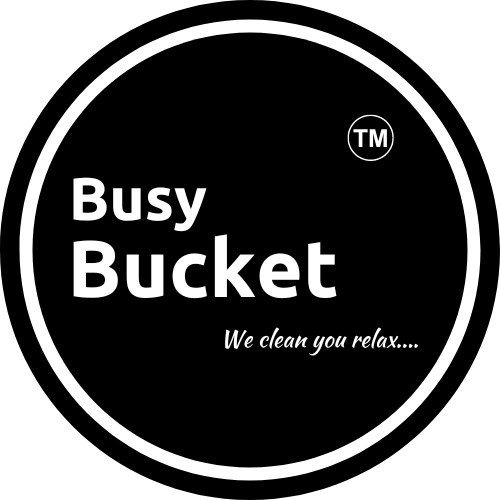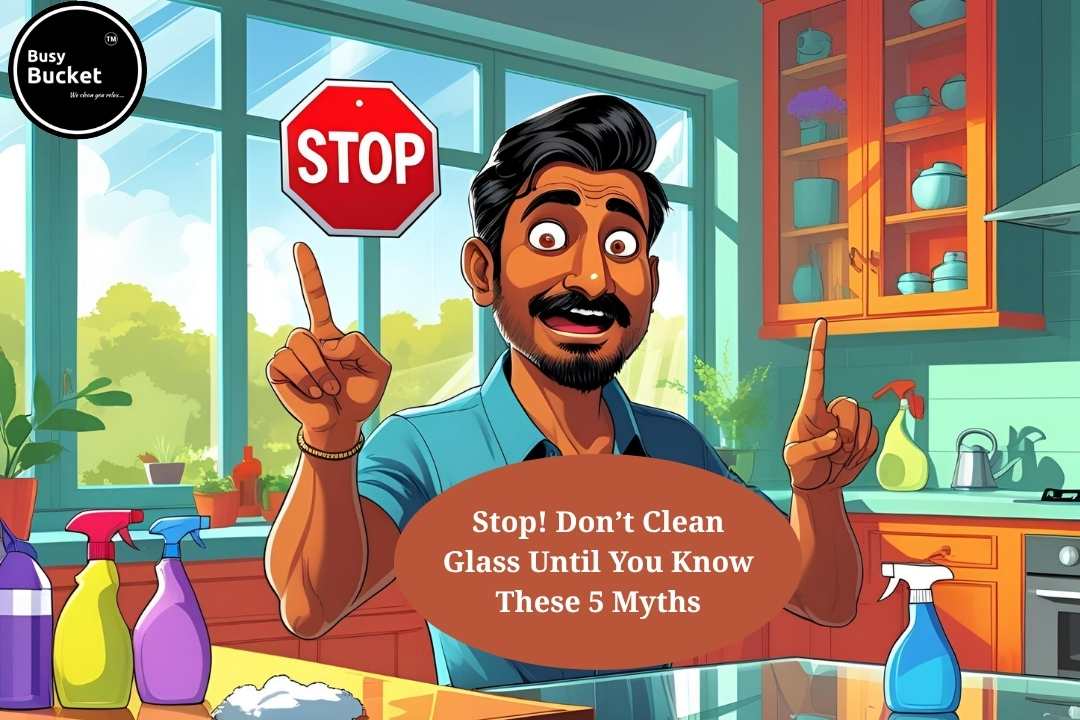There’s a lot of cleaning advice out there that sounds smart — but it’s actually doing more harm than good. From grandma’s vinegar tricks to TikTok’s latest DIY hacks, it’s time to clear the air on glass cleaning myths that refuse to die.
In this guide, we’re breaking down 5 of the most common myths — and giving you the real truth — so your glass always looks crystal clear without wasted effort or damage.
Why This Matters for First-Time Renters and Homeowners
When you are living on your own for the first time, you may be surprised at how quickly glass gets dirty and how tricky it can be to achieve that perfect streak-free shine. The first question that comes to mind is: how do you clean window glass properly?
Whether it is your shower door, your bedroom mirror, or those big bright windows, poor cleaning habits can cause scratches, hazy spots, and even long-term damage. That’s why busting these glass cleaning myths is your first step toward a cleaner, calmer home.
Myth 1: Newspaper Is the Best Tool for Cleaning Glass
The Myth: Use old newspaper! It is streak-free magic.
The Truth:
Back in the day, this tip kind of worked — but that was when newspapers were thicker and used oil-based ink. Today’s paper is thinner, often printed with water-based ink that smears and leaves lint. You might even notice black residue or smudges that weren’t there before.
Plus, newspaper isn’t great at absorbing moisture, so you end up spreading the cleaner around rather than lifting it off the surface.
What to Use Instead:
- Microfiber cloths – Gentle on surfaces, highly absorbent, and can be used multiple times.
- Avoid paper towels – They are not much better than newspaper and leave behind fuzz.
Glass cleaning myths like this one are stuck in the past — microfiber is your modern-day BFF.
Myth 2: Vinegar Works for Every Type of Glass Cleaning
The Myth: Just use vinegar and water — it works on everything!
The Truth:
This one is half true. Vinegar is a great natural degreaser and disinfectant. But when it comes to glass cleaning, it has its limits:
- Does not cut through heavy grease (especially on kitchen glass).
- Can damage tinted windows or coated glass.
- The smell can be overpowering in small rooms.
What to Do Instead:
For a simple DIY solution that works better:
- Take equal parts of vinegar with water also add some dish soap.
- Shake well before each use.
- Spot test if you are unsure about surface coatings.
If you are dealing with thick grime, use a commercial ammonia-free glass cleaner made specifically for household glass. Not every glass surface is the same — so be cautious of universal vinegar-based hacks.
Myth 3: Glass Doesn’t Really Get Dirty — Just Dusty
The Myth: It just needs a wipe now and then.
The Truth:
This myth massively underestimates how dirty glass can get. Glass may seem smooth and clean to the eye, but it’s constantly exposed to:
- Fingerprints and skin oils
- Water spots and hard minerals
- Grease splatters
- Dust and airborne particles
- Soap scum in bathrooms
Especially in kitchens and bathrooms, skipping regular cleaning leads to cloudiness, streaks, and long-term build-up that becomes much harder to remove.
What to Do:
Add glass surfaces to your weekly cleaning rotation, just like you do floors or counters. And remember:
- Dry dust the surface first to prevent scratching.
- Follow with your cleaner and microfiber cloth.
- Wipe down the shower glass with a squeegee after each use to reduce soap scum buildup.
Getting ahead of the grime saves time in the long run — and you will never be caught off guard by surprise guests.
Myth 4: Homemade Cleaning Solutions Are Always Safe
The Myth: If it is made at home, it cannot be harmful
It is a popular belief in the DIY community — and yes, some natural cleaners are great alternatives. But don’t assume homemade = safe for all situations.
The Truth:
Many DIY combos are either ineffective or dangerous:
- Vinegar + baking soda: This fizzing mix is fun to watch but doesn’t clean glass well. The two neutralize each other, making the solution mostly water.
- Vinegar + bleach: Never mix! This creates toxic chlorine gas — extremely dangerous.
What to Do:
Stick to:
- Simple DIYs with just water, vinegar, and a little soap.
- Store-bought cleaners labeled safe for your specific glass type.
- Always spot-test on a small corner before applying to a large area.
Do not let well-meaning advice lead to expensive mistakes — this is one of the most common glass cleaning myths out there.
Myth 5: The Truth About Window Cleaning Techniques Doesn’t Matter
The Myth: Just wipe it down — how hard can it be?
The Truth:
Technique matters a lot. Bad wiping techniques can:
- Leave visible streaks
- Push dirt around instead of lifting it
- Create static that attracts more dust
What to Do:
Here’s how to clean glass like a pro:
The right technique:
When cleaning your glass, try using an “S” or zigzag motion instead of going in circles. This helps avoid streaks and gives a better finish. Always wipe with one side of your cloth first, then switch to the clean side to dry it off.
Start at the top and work your way down so you can catch any drips as you go. Also, it’s a good idea to use different cloths for the inside and outside of the glass since the outdoor side usually has more dirt and grime.
Bonus Section: Different Glass = Different Rules
Not all glass is created equal. Here’s how to treat common glass types the right way:
Mirrors (especially in bathrooms)
- Always spray the cleaner onto the cloth to avoid adding moisture directly to the glass.
- Use a dry cloth to gently polish the surface and avoid water spots.
- Use an anti-fog spray in high humidity areas.
Shower Doors
- Use a squeegee after every use.
- Once a month, clean using a mixture of baking soda and vinegar paste, then rinse well.
- Avoid harsh scrubbing pads that can scratch the glass.
Kitchen Glass
- Degrease with warm water and dish soap.
- Then use a vinegar mix or commercial glass cleaner.
- Clean appliance glass (like oven doors) with specialty cleaners to avoid surface damage.
Windows (Indoor & Outdoor)
- Clean both sides seasonally for best visibility.
- Use a small brush or toothbrush to clean window tracks.
- Rinse with water if you are dealing with outdoor dust or pollen before applying cleaner.
Glass and window cleaning often takes a lot of time and effort. We, Busy Bucket handle it for you and make your life easier. We are the leading home cleaning service provider near Chandigarh and Mohali. Our expert glass cleaning services in Chandigarh help you save time and effort so you can enjoy a clear view without any headache.
Final Thoughts: Bust the Myths, Win the Shine
Glass cleaning doesn’t have to be stressful. The real challenge is not the scrubbing. It is about understanding what works and what does not. By ditching these common glass cleaning myths, you will protect your surfaces, save time, and get that streak-free glow everyone loves.
So, the next time someone suggests using vinegar and newspaper to clean your glass, you will know there is a better way. When it comes to glass cleaning, working smarter always beats working harder.
Frequently Asked Questions
How often should I clean my windows or glass surfaces?
It depends on your environment, but a general rule is to clean them every 2 to 4 weeks. If you live in a dusty area or near a busy road, you might need to clean them more.
Why do my windows still look streaky even after cleaning?
Streaks usually happen when too much cleaner is used or when it’s wiped with a dirty or damp cloth. Try using a microfiber cloth and wipe in an “S” pattern instead of circles.
Can I just use newspaper and vinegar to clean glass?
While this old-school method is popular, it does not always give the best results. Newspaper can leave ink smudges, and vinegar alone might not cut through heavy grime.


